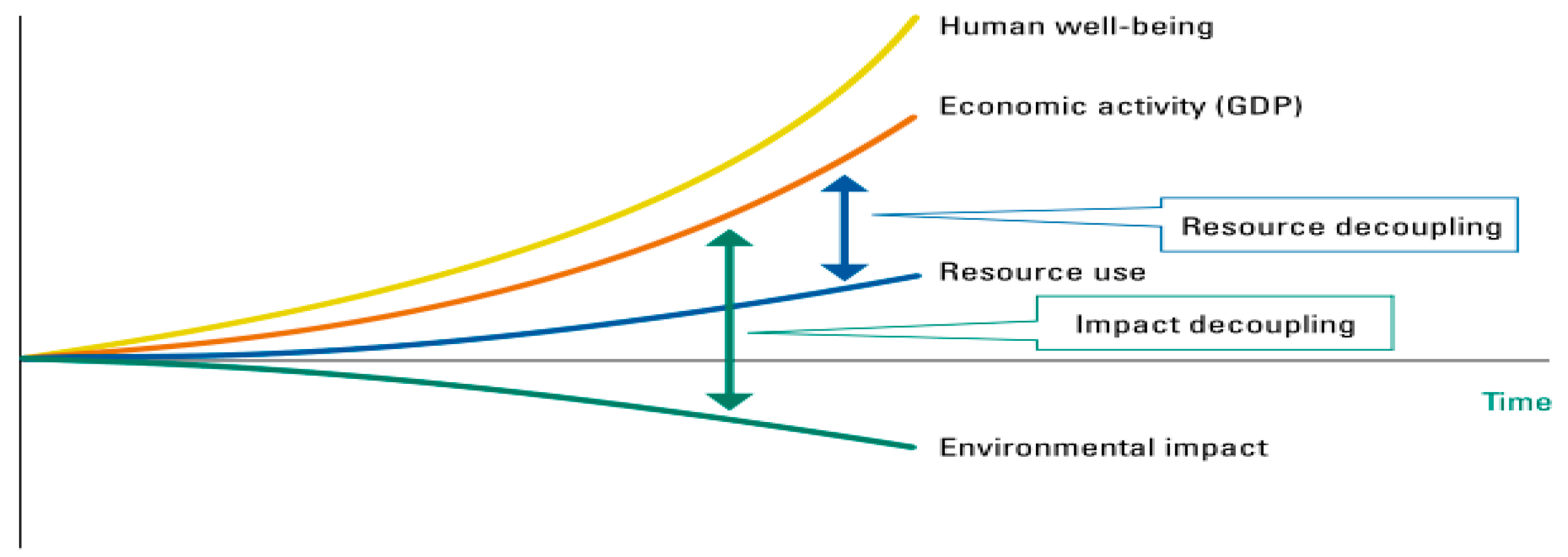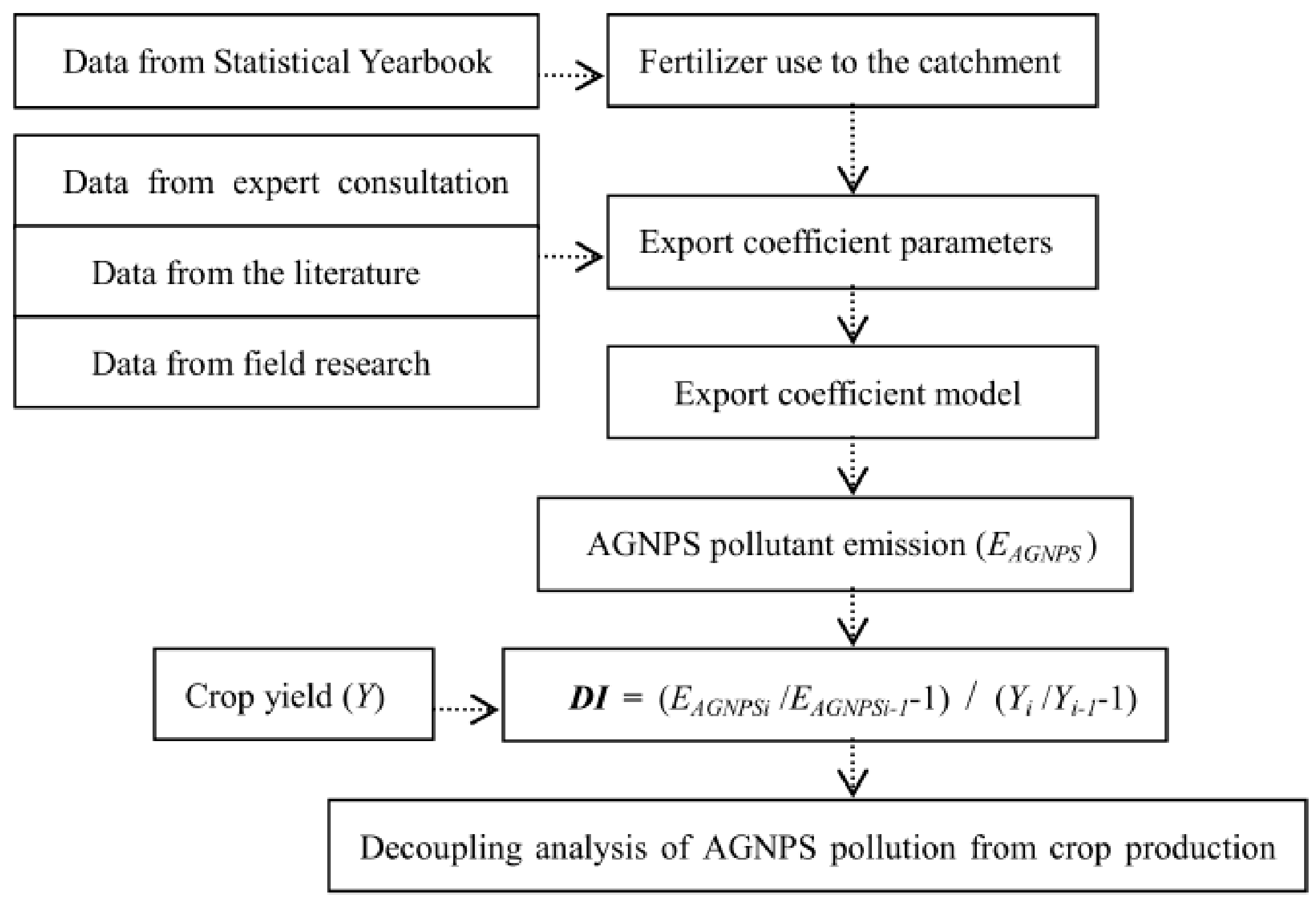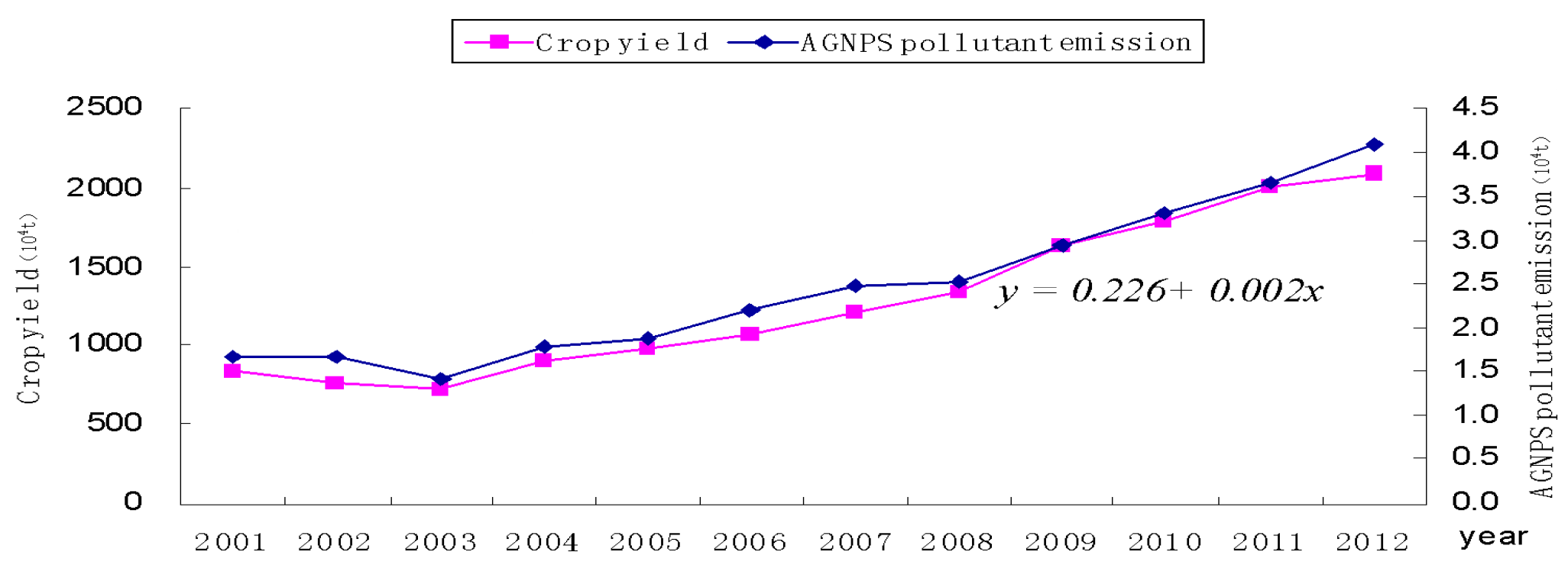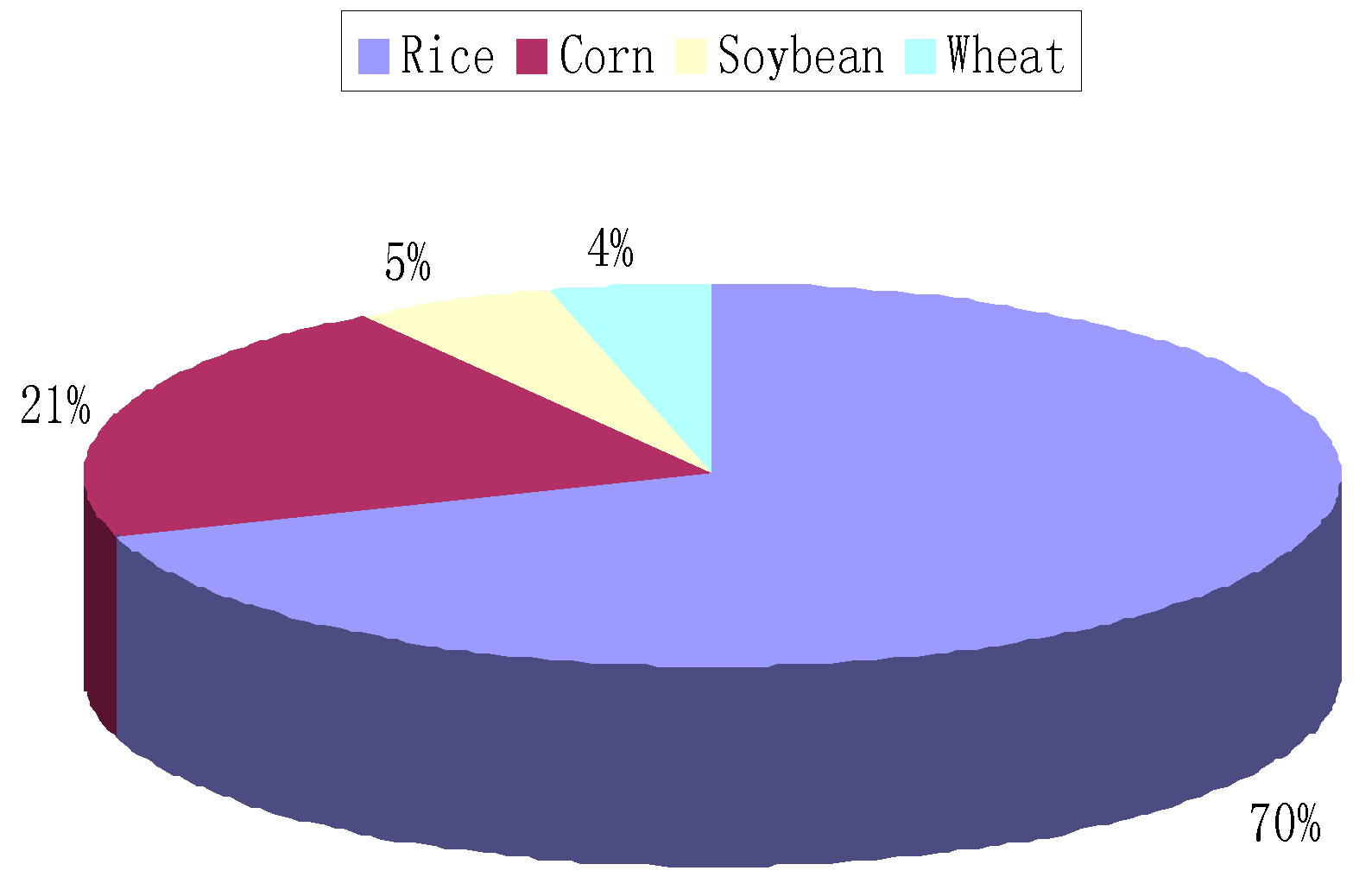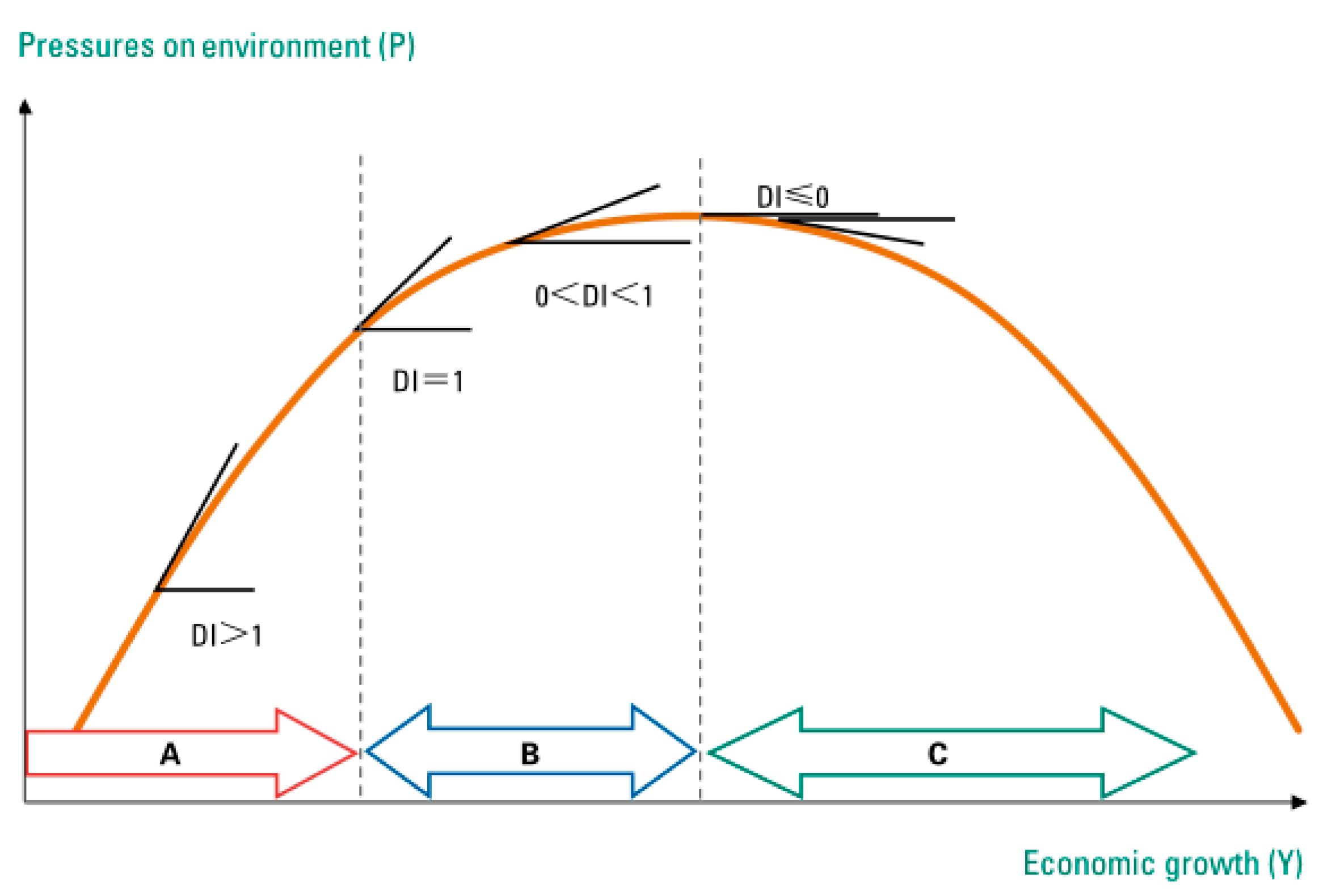1. Introduction
Whether environmental pressure can be reduced during periods of economic growth has been intensively discussed [
1,
2]. From the perspective of methods to evaluate the relationship between economic growth and environmental pressure, following the Environmental Kuznets Curve (EKC) [
3], “decoupling”, originating from physics, was extended to break the link between “environmental bads” and “economic goods” [
4]. When used in this extended sense, decoupling implies that the growth rate of environmental pressure is less than that of its economic development over a given period (
Figure 1) [
5]. Now, decoupling environmental pressure from human well-being has become the policy goal of the Green Economy Initiative of the United Nations Environment Programme (UNEP) and the European Union (EU).
Literature on decoupling/coupling degrees generally considers strong decoupling, weak decoupling, recessive decoupling, strong coupling, weak coupling and expansive coupling [
6,
7,
8,
9,
10], and both indicators and methods of decoupling analysis are in continuous development [
11,
12,
13,
14]. However, literature on decoupling analysis of crop production is rare, such as decoupling crop production from soil erosion, irrigation water consumption and fertilizer application [
15,
16,
17] and decoupling agricultural water consumption and environmental impact from crop production based on the water footprint method [
18].
Fertilizer application is a leading cause of agriculture nonpoint source (AGNPS) pollution in China, the United States and worldwide [
19,
20,
21,
22]. China is the biggest fertilizer user in the world, its ratio of fertilizer utilization is low (30–35%), but studies on AGNPS pollution are still in an early stage of development [
23]. The lack of reliable data further limits accurate evaluation of AGNPS pollution, which hampers local decision making and regional sustainable development. The Heilongjiang land reclamation area (HLRA) is located in Northeast China, its arable land area per capita is 15 times greater than that of the national average, and its crop yield per unit area exceeds that of the United States. With the crop yield continuously increasing for 12 years, AGNPS pollution via fertilizer application constitutes 80% of the water pollution in the HLRA [
24], which further threatens regional food security and ecological security.
The purpose of this study is to examine the decoupling/coupling degrees between high crop yield and agricultural water pollution during 2001–2012 in the HLRA. The remainder of this paper has four parts:
Section 2 introduces methods and materials, including the decoupling index, export coefficient model, study area and data source;
Section 3 provides results;
Section 4 is the discussion; and
Section 5 states the final conclusions.
2. Methods and Materials
2.1. Decoupling Index (DI)
In this article, the decoupling index (DI) aims to indicate the relationship between the change in the rate of AGNPS pollutant emission and change in the rate of crop yield within a certain time period (typically 1 year). The DI is expressed as
where
EAGNPS represents the load of nutrient loss (via fertilizer application) exported into surface water;
EAGNPSi and
EAGNPSi−1 represent AGNPS pollutant emission at the last phase and the base period, respectively;
Y represents crop yield; and
Yi and
Yi−1 represent the crop yield at the last phase and the base period, respectively. Using the difference (Δ) between AGNPS pollutant emission (
EAGNPS) and crop yield (
Y) at two points in time (1 year in this study),
ΔEAGNPS represents the change rate of AGNPS pollutant emission from the last phase to the base period.
ΔY is the growth rate of crop yield from the last phase to the base period. Six possible combinations of change in
EAGNPS,
Y and
EAGNPS/Y can be interpreted as different degrees of the decoupling/coupling process (
Table 1).
2.2. Export Coefficient Model
Based on the limited available data and the scattered farmland, AGNPS pollution from fertilizer application in the HLRA was estimated and hindcast using the export coefficient model [
19], where fertilizer inputs and export coefficients are divided by each agricultural crop. The AGNPS pollutant emission was computed using the following equation:
where
L is loss of nutrients. In this study, we take the nitrogen loss leached into surface water as the indicator for AGNPS pollution in the HLRA.
E is the export coefficient for nutrient source
i;
A is the area of catchment occupied by crop
i, where the main crops in the HLRA include rice, corn, soybean and wheat;
I is the input of nutrients to source
i; and
P is the input of nutrients out of rainfall (omitted here) [
19].
Nitrogen (the most substantial component of the fertilizers) is used as the case pollutant to account for AGNPS pollution [
25,
26,
27]. In this study, a chemical fertilizer application was deployed as the main pollutant; nitrogen loss was adopted as the main pollutant indicator; and, however, pesticide application was not considered due to its complexity [
28,
29]. In the HLRA, chemical pesticide is normally applied by aero spraying, and the application dosage of chemical pesticides is only 3.69 kg/ha, which is far below the national standard of 15.23 kg/ha [
18,
30]. Therefore, the AGNPS pollutant emission in this study is relatively conservative.
The overall scheme for the decoupling analysis is shown in
Figure 2.
2.3. Study Area and Data Source
The HLRA is located at 123°32′–134°33′ E, 43°56′–50°21′ N, covering an area of 57,600 km
2 and including 113 state farms attached to nine branches. It is characteristic of the mid-temperate and cold temperate continental monsoon climate. The annual rainfall is approximately 540 mm/year, with 80–90% of precipitation occurring from May to September. The study area belongs to three fluvial systems, including the Heilong River, the Wusuli River and the Songhua River (
Figure 3), and the total amount of water resources in the HLRA is 9.76 billion m
3, including 5.6 billion m
3 of surface water and 4.09 billion m
3 of groundwater [
31].
The main crops in the HLRA include rice, corn, soybean and wheat, which accounted for approximately 95% of the total crop yield in the most recent decade [
32]. The data used for the export coefficient model included data on crop yield, fertilizer usage and annual loads of nitrogen loss delivered into surface water. Historical data on crop yield and fertilizer usage came from the Statistical Yearbook of Heilongjiang Land Reclamation Area (2002–2013). The fertilizers applied in crop growth included urea, diammonium phosphate, potassium chloride and potassium sulfate. Export coefficients for the four main crops in the HLRA were calculated based on data from field research, literature [
18,
24,
33,
34,
35] and expert consultation, as shown on
Table 2.
3. Results
3.1. Relationship between Crop Yield and AGNPS Pollution
The changes in crop yield and AGNPS pollution via fertilizer application during 2001–2012 in the HLRA are shown in
Figure 4.
Both crop yield and AGNPS pollutant emission via fertilizer application generally increased during these years. The correlation coefficient r between crop yield and the AGNPS pollutant emission was 0.993 at the 0.01 significance level. Using crop yield as the independent variable x and the AGNPS pollutant emission as the dependent variable y, the equation used to relate these two factors is y = 0.226 + 0.002x. The r2 value was 0.985, and the adjusted r2 value was 0.984. The goodness-of-fit of the equation was higher, and the high r2 value indicated a close relationship between the AGNPS pollutant emission and crop yield, especially in 2009–2011.
3.2. Decoupling AGNPS Pollution from Crop Production
Based on the criteria for the decoupling/coupling degrees (
Table 2), the results of decoupling AGNPS pollution from crop production during 2001–2012 in the HLRA are shown in
Table 3, and the results based on the average value between 2001 and 2012 are shown in
Table 4.
During 2001–2012, weak decoupling occurred for 6 years, recessive decoupling occurred for 1 year, weak coupling occurred for 1 year, and expansive coupling occurred for 3 years. In the years of decoupling tendency, AGNPS pollution via fertilizer application rapidly increased, and the increase in crop yield was greater than the increase of AGNPS pollutant emission via fertilizer application. Weak decoupling frequently occurred but was accompanied by fluctuation, and no strong decoupling occurred during those years. During the years of coupling tendency, the increase in crop yield was less than the increase in AGNPS pollutant emission via fertilizer application. The fact that expansive coupling occurred for 3 years indicated that the HLRA had a long way to go for constructing an ecological agricultural production system, despite its high crop yield and high potential productivity in China.
Due to the close relationship between crop production and AGNPS pollution, crop yield largely depended on increased fertilizer application. According to
Table 4, which was based on the mean values in 2001–2012, each branch in the HLRA had a weak decoupling relationship between crop production and AGNPS pollution from fertilizer use. The growth rate of crop yield for each branch was greater than that of the increasing rate of AGNPS pollutant emission from fertilizer application, which showed the potential to reach a strong decoupling across the whole HLRA.
3.3. Example: Decoupling AGNPS Pollution from Rice Production
Rice is a primary food source and an important cereal plant. Rice yield in Northeast China accounted for 40% of the Country’s production [
36]. Due to rice’s comparative advantage and famous quality, the cultivated area of rice in the HLRA increased rapidly, except in 2003 and 2008, and the rice yield in the four eastern branches constituted 92.76% of the total rice yield in the HLRA. In addition, water consumption for rice production constituted half of the total during crop growth [
18,
24], and rice production became the largest source of AGNPS pollution in the HLRA (
Figure 5).
The results of decoupling AGNPS pollution from rice production during 2001–2012, which are based on the average value of each branch in the HLRA (2001–2012), are shown in
Table 5 and
Table 6.
According to
Table 5, during 2001–2012 in the HLRA, weak decoupling occurred for 6 years, expansive coupling occurred for 3 years, and recessive decoupling and strong coupling occurred for 1 year. Compared with the base year of 2002, although the HLRA achieved the largest reduction in AGNPS pollutant emission (−20.11%) in 2003, the growth rate of rice yield also decreased (−6.32%), which was not ideal for coordinating the relationship between crop growth and environmental protection. The worst degree of strong coupling occurred in 2002, when the growth rate of rice yield decreased 14.15% and the growth rate of AGNPS pollutant emission increased 2.46%. Expansive coupling occurred in 2006, 2010 and 2012, which indicated that there were no definite signs of improvement to the water environment in rice production.
In
Table 6, based on the average value of each branch during 2001–2012, all branches in the HLRA, except for the Suihua branch, reached weak decoupling. The Suihua branch achieved a lower growth rate of AGNPS pollutant emission (5.27%); however, it achieved the lowest growth rate of rice yield (4.90%). Thus, it was the backward branch, and its degree of expansion coupling urgently needs improvement.
According to
Figure 5,
Table 5 and
Table 6, it was found that the key problem resulted from rice production and that it is necessary to pay more attention to optimizing fertilizer application and field management during the process of rice growth, both for the whole HLRA and for the Suihua branch in particular.
4. Discussion
Based on the results of this study, some related findings and discussions are proposed to promote sustainability studies.
(1) Ensuring food safety is the first priority for China, which is both the most populous country and a vast agricultural country. However, increasingly serious environmental problems and the need for sustainable agricultural development both force us to pay close attention to environmental protection. Great efforts have been made to coordinate crop production and the agricultural ecological environment in China, including the “Water Pollution Control Action Plan”, issued in 2015. However, progress in AGNPS control is still slow.
The HLRA is the representative of advanced crop production and the largest green-food production base in China; the rate of its agricultural mechanization has reached 94%, the mode of testing soil for formulated fertilization occupies 90% of field planting, and fertilizer application by aerial spraying is widespread (generally an airplane can apply fertilizer to a 40 thousand ha paddy field) [
24]. However, it is uncertain whether this study area has done its best to coordinate crop growth with environmental pressure or how great the gap is between what has been accomplished here and what has been accomplished in developed countries and regions.
As seen from the indicators of fertilizer application in different countries/regions (
Table 7), it is not possible to draw a conclusion based on only fertilizer application amount, fertilizer input per unit area or fertilizer input per unit crop yield. Even with similar values of fertilizer application, AGNPS pollution during the process of crop production may vary widely, due to differences in annual rainfall, efficiency of agricultural water use, fertilizer use efficiency, fertilizer leaching rate, crop structure, cropping system and technology innovation. In light of these considerations, it is tenable to use the decoupling analysis as a practical method for regional comparative study based on a spatiotemporal angle.
(2) Scholars prefer to adopt sustainability assessment methods with more indicators that are used more prevalently in the literature; adopting these methods facilitates comparison and mutual authentication [
37]. On the topic of examining the relationship between economic growth and environmental pressure, a decoupling analysis can be integrated with other traditional methods. For example, it is possible to compare the decoupling/coupling degrees with the corresponding stages of the EKC, according to different DI and the corresponding area A, B and C shown in
Figure 6 [
5]. When integrated in this way, these two methods can corroborate, complement and reinforce each other.
(3) Decoupling indicators shed light on particular aspects of a complex reality but leave out other aspects, and the decoupling concept lacks an automatic link to the environment’s process [
5,
11]. As a result, a policy based on decoupling analysis is not enough to coordinate the relationship between crop production and environmental degradation. It is, however, known that over-use of fertilizer and low fertilizer-use efficiency are contributors to AGNPS pollution. The next step is to put forward pertinent suggestions for local policy making, especially for factors playing a role in reducing AGNPS pollution, such as the efficiency of agricultural water use, fertilizer variety, fertilizer use efficiency, crop structural adjustment, cropping system and technology innovation.
5. Conclusions
Using decoupling analysis to evaluate the relationship between regional economic growth and environmental impact has received increasing attention in sustainability studies. From the perspective of AGNPS pollution, fertilizer application has been a major source of water pollution in recent decades accompanied by an increasing crop yield, and this trend will likely continue in many countries.
The results of decoupling AGNPS pollution from crop production in the HLRA indicated that the trend of weak decoupling occurred for 6 years, and that recessive decoupling occurred for 1 year in 2001–2012. In addition, weak decoupling occurred more in each branch, as is evident from the average value (2001–2012). For the example of decoupling AGNPS pollution from rice production, weak decoupling occurred half of the time during 2001–2012, and all branches, except for the Suihua branch, in the HLRA reached weak decoupling from the standpoint of the average value (2001–2012).
According to the results of the decoupling analysis, the authors found a high appearance frequency of weak decoupling during 2001–2012 in the HLRA, but the status of weak decoupling was not steady over time. A decoupling tendency and environmental deterioration coexist in the past and present, and the high appearance frequency of weak decoupling does not mean that a strong decoupling will be realized over the next decade or at some later time. It was also revealed that rice production is the leading source of AGNPS pollution in the HLRA, and that optimizing the fertilizer application and field management of rice growth will become a very important task in the future.
Acknowledgments
We thank the National Natural Science Foundation of China (41571115, 41271555 and 41630749) for funding this work.
Author Contributions
Q.Y. conceptualized the study design. J.L. collected and analyzed the data. Y.Z. conducted the data analysis and wrote the manuscript. All authors read, revised and approved the final manuscript.
Conflicts of Interest
The authors declare no conflict of interest.
References
- Arrow, K.; Bolin, B.; Costanza, R.; Dasgupta, P.; Folke, C.; Holling, C.S.; Jansson, B.O.; Levin, S.; Maler, K.G.; Perrings, C.; et al. Economic growth, carrying capacity, and the environment. Science 1995, 268, 520–521. [Google Scholar] [CrossRef] [PubMed]
- Holdren, J.P. Science and technology for sustainable well-being. Science 2008, 319, 424–434. [Google Scholar] [CrossRef]
- Grossman, G.M.; Krueger, A.B. Economic growth and the environment. Q. J. Econ. 1995, 110, 353–377. [Google Scholar] [CrossRef]
- OECD. Indicators to Measure Decoupling of Environmental Pressure from Economic Growth; OECD: Paris, France, 2002; pp. 1–3. [Google Scholar]
- UNEP. Decoupling Natural Resource Use and Environmental Impacts from Economic Growth; A Report of the Working Group on Decoupling to the International Resource Panel; UNEP: Nairobi, Kenya, 2011; pp. 1–174. [Google Scholar]
- Diakoulaki, D.; Mandaraka, M. Decomposition analysis for assessing the progress in decoupling industrial growth from CO2 emissions in the EU manufacturing sector. Energy Econ. 2007, 29, 636–664. [Google Scholar] [CrossRef]
- Andreoni, V.; Galmarini, S. Decoupling economic growth from carbon dioxide emissions: A decomposition analysis of Italian energy consumption. Energy 2012, 44, 682–691. [Google Scholar] [CrossRef]
- Freitas, L.C.; Kaneko, S. Decomposing the decoupling of CO2 emissions and economic growth in Brazil. Ecol. Econ. 2011, 70, 1459–1469. [Google Scholar] [CrossRef]
- Zhang, Y.; Da, Y. The decomposition of energy-related carbon emission and its decoupling with economic growth in China. Renew. Sustain. Energy Rev. 2015, 41, 1255–1266. [Google Scholar] [CrossRef]
- Liang, S.; Liu, Z.; Crawford-Brown, D.; Wang, Y.; Xu, M. Decoupling Analysis and Socioeconomic Drivers of Environmental Pressure in China. Environ. Sci. Technol. 2014, 48, 1103–1113. [Google Scholar] [CrossRef] [PubMed]
- OECD. Environmental Indicators-Development, Measurement and Use; OECD: Paris, France, 2003; p. 137. [Google Scholar]
- Tapio, P. Towards a theory of decoupling: Degrees of decoupling in the EU and the case of road traffic in Finland between 1970 and 2001. J. Transp. Policy 2005, 12, 137–151. [Google Scholar] [CrossRef]
- Brizga, J.; Feng, K.; Hubacek, K. Drivers of CO2 emissions in the former Soviet Union: A country level IPAT analysis from 1990 to 2010. Energy 2013, 59, 743–753. [Google Scholar] [CrossRef]
- Zhang, Z.; Chen, X.; Heck, P.; Xue, B.; Liu, Y. Empirical study on the environmental pressure versus economic growth in China during 1991–2012. Resour. Conserv. Recyl. 2015, 101, 182–193. [Google Scholar] [CrossRef]
- He, X.; Wen, A.; Zhang, X.; Zhu, B. Decoupled index system of soil erosion in agricultural ecological environment evaluation. J. Soil. 2005, 42, 852–856. [Google Scholar]
- Yu, F. Decoupling irrigation water from crop production in China. Chin. Rural Econ. 2008, 10, 33–34. [Google Scholar]
- Xu, W.; Zhang, J.; Li, S.; Sun, X. Decoupling research on relationship between chemical fertilizer usage from crop production in the cyclic agriculture in China. Agric. Mod. Res. 2010, 31, 200–203. [Google Scholar]
- Zhang, Y.; Yang, Q. Decoupling agricultural water consumption and environmental impact from crop production based on the water footprint method: A case study for the Heilongjiang land reclamation area, China. Ecol. Indic. 2014, 43, 29–35. [Google Scholar]
- Johnes, P.J. Evaluation and management of the impact of land use change on the nitrogen and phosphorus load delivered to surface waters: The export coefficient modeling approach. J. Hydrol. 1996, 183, 323–349. [Google Scholar] [CrossRef]
- Shen, Z.; Hong, Q.; Yu, H.; Liu, R. Parameter uncertainty analysis of the nonpoint source pollution in the Daning River watershed of the Three Gorges Reservoir Region, China. Sci. Total Environ. 2008, 405, 195–205. [Google Scholar] [CrossRef] [PubMed]
- Haregeweyn, N.; Yohannes, F. Testing and evaluation of the agricultural nonpoint source pollution model (AGNPS) on Augucho catchment, western Hararghe, Ethiopia. Agric. Ecosyst. Environ. 2003, 99, 201–212. [Google Scholar] [CrossRef]
- Lee, S.W.; Hwang, S.J.; Lee, S.B.; Hwang, H.S.; Sung, H.C. Landscape ecological approach to the relationships of land use patterns in watersheds to water quality characteristics. Lands. Urban Plan. 2009, 92, 80–89. [Google Scholar] [CrossRef]
- Wang, J.; Cheng, L. Analysis of agricultural nonpoint source pollution. Acta Agric. Univ. Jiangxiensis 2008, 9, 35–39. [Google Scholar]
- Zhang, Y.; Zhang, Z.; Su, M. Research on grey water footprint based on chemical fertilizer use in the grain production in Heilongjiang reclamation area. J. Arid Land Resour. Environ. 2013, 7, 28–32. [Google Scholar]
- Hoekstra, A.Y.; Chapagain, A.K.; Aldaya, M.M.; Mekonnen, M.M. Water Footprint Assessment Manual: Setting the Global Standard; Earthscan: London, UK, 2011. [Google Scholar]
- Zhang, Y.; Li, Y.; Ouyang, Z.; Liu, J. The grey water footprint of the winter wheat-summer maize crop rotation system of the North China Plain. Acta Ecol. Sin. 2015, 35, 6647–6654. [Google Scholar]
- Mekonnen, M.M.; Hoekstra, A.Y. The green, blue and grey water footprint of crops and derived crop products. Hydrol. Earth Syst. Sci. 2011, 15, 1577–1600. [Google Scholar] [CrossRef]
- Mekonnen, M.M.; Hoekstra, A.Y. A global and high-resolution assessment of the green, blue and grey water footprint of wheat. Hydrol. Earth Syst. Sci. 2010, 14, 1259–1276. [Google Scholar] [CrossRef]
- Li, H.; Wang, L.; Qiu, J.; Li, C.; Gao, M.; Gao, C. Calibration of DNDC model for nitrate leaching from an intensively cultivated region of Northern China. Geoderma 2014, 223, 108–118. [Google Scholar] [CrossRef]
- Liu, Q.; Chen, M.; Zhu, L. Measures for Agricultural ecological environment protection in the Heilongjiang land reclamation area. Mod. Agric. 2008, 1, 8–10. [Google Scholar]
- Sun, D. Water resources and its development and utilization in the Heilongjiang land reclamation area. Water Resour. Plan. Des. 2010, 5, 17–18. [Google Scholar]
- Lai, Y.; Liu, X.; Yang, Z. Modern agricultural development in the Heilongjiang land reclamation area. Mod. Agric. 2011, 2, 42–43. [Google Scholar]
- Han, X.; Wang, S.; Song, C.; Qiao, Y. Fate of fertilizer nitrogen in paddy field of black soil region. Chin. J. Appl. Ecol. 2003, 14, 1859–1862. [Google Scholar]
- Jin, C.; Li, H.; Cai, Y. Discussion on investigation method of surface source pollution in Songhuajiang river basin. Water Resour. Hydropower Northeast China 2004, 22, 54–55. [Google Scholar]
- Zhao, W.; Wang, H.; Chen, Y.; Wang, D.; Yu, J.; Song, L. Effects of manure and chemical fertilizers application on nitrogen leaching in black soil. J. Northeast Agric. Univ. 2010, 41, 47–52. [Google Scholar]
- Yu, Y.; Huang, Y.; Zhang, W. Changes in rice yields in China since 1980 associated with cultivar improvement, climate and crop management. Field Crops Res. 2012, 136, 65–75. [Google Scholar] [CrossRef]
- International Union for Conservation of Nature and Natural Resources (IUCN). IUCN Resource Kit for Sustainability Assessment; IUCN: Gland, Switzerland, 2001; pp. 1–3. [Google Scholar]
© 2017 by the authors. Licensee MDPI, Basel, Switzerland. This article is an open access article distributed under the terms and conditions of the Creative Commons Attribution (CC BY) license (http://creativecommons.org/licenses/by/4.0/).
